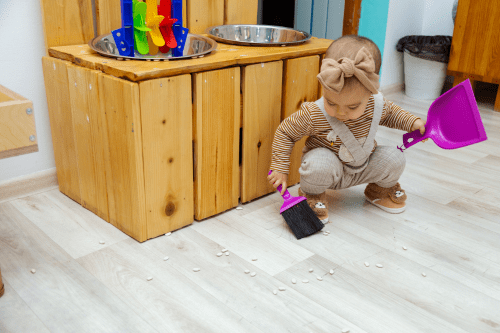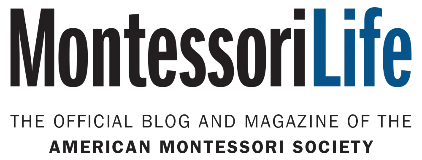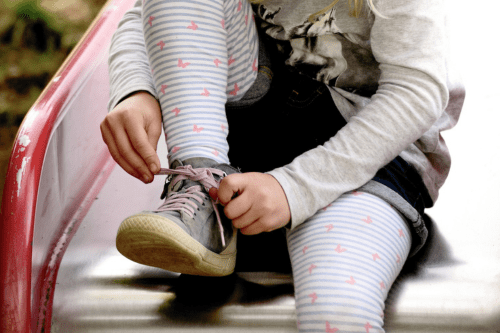Walking into a Montessori Early Childhood classroom for the first time, the visitor may be surprised by a number of activities taking place: small children sweeping the floor, polishing the leaves of a plant, scrubbing a table, or washing dishes. In a different area of the classroom, a child may be preparing their own snack or arranging a vase of flowers. Another child, getting up from a chair, carefully tucks it in under the table. Even more surprising is that the children, so engaged, carry out these activities with purposeful movement and independence.
These activities are examples of Practical Life exercises, a hallmark of Montessori education. While, at first glance, the child may appear to be involved in domestic chores, they are “in reality busily at work on [their] development—and the method of [their] learning is through movement” (Montessori 2017, 34). The aim of table washing, in other words, is much more than a clean table. We’ll come back to this.
Young children are highly motivated to engage in those activities they commonly see at home; anyone who has ever had a small child in the household knows that they frequently ask to help with cooking, washing dishes, folding clothes, or laying the table. To this end, many homes and schools provide items like toy kitchen sets with which the child imitates the chores of older siblings, caregivers, and parents. But “Real, true purpose is a hallmark of Practical Life” (Lillard 2008). These make-believe activities do not satisfy the child’s need “to exert themselves in their surroundings” (Montessori 1948/2019, 86) as they have no practical purpose; that is, the child does not see a real-life result of their play. Integrating Practical Life activities—work, not play—into the real aspects of caring for oneself and the environment “… seeks to give all this to the child in reality—making him an actor in a living scene” (Montessori in Lillard 2008).
Why is this important, and what does Montessori Practical Life look like through the ages? This series examines the types, aims, and examples of such activities at the Early Childhood, Elementary, and Secondary levels. Additionally, we will examine the correspondence of Montessori’s ideas about child development—as they relate to the Practical Life exercises—to Erik Erikson’s psycho-social stages of development.
Practical Life Exercises in the Early Childhood Classroom

|
Through Practical Life exercises, “toddlers and preschool-age children learn to work independently, develop concentration, and prepare for later work with reading and math.” The most common and traditional EC Practical Life “works” involve exercises in caring for the classroom environment, food preparation, and personal care and hygiene. The materials and equipment for carrying out these tasks usually include some form of the following:
An important aspect of these exercises is the opportunity for freedom of choice, movement, and repetitive practice. Any number of the activities described above are available throughout the work cycle, and the child is free to choose those to which they are called, either by implicit interest or because the activity fulfills a need for movement and/or order. Furthermore, the child can repeat an activity as often as they wish, while practicing large and small motor movements. To those unfamiliar with Montessori Education, among the most notable aspects of these exercises is that some of the small containers used are made of breakable glass or ceramics. The objects are treated as important, even special, during the teacher’s presentation and, subsequently, during the child’s use. Unlike a plastic container that can be dropped with no consequence, a cup or bowl made of glass or ceramics might very well shatter if the child drops it. Should this occur, they are shown how to very carefully sweep up the pieces. The use of breakable items not only encourages the child to control their movements to prevent such accidents, but also to follow through when accidents do occur. This is one of the most important elements of the Practical Life exercises—seeing a task through to its practical completion. Mopping up a water spill, sweeping up crumbs from one’s snack, or zipping one’s jacket are feats of independence, and the child “is thus freed from the greatest of all dangers, that of making an adult responsible for his actions” (Montessori 1948/2019, 96). Practical Life and Erik Erikson’s Developmental ModelA child’s drive toward control and autonomy is further explicated in Erik Erikson’s lifespan model of psycho-social development, in which each life stage is characterized by a crisis and corresponding outcome. Erikson’s stages below are descriptive of the child in Montessori’s first plane of development:
Given that Erikson was Montessori trained and certified, it is likely that his theories about child development were, at least partially, impacted by Montessori’s ideas. We see echoes of Montessori philosophy in his theory, and the Practical Life exercises are the precise sorts of tasks that encourage the outcomes described in Erikson’s model. Practical Life and Indirect PreparationThe Practical Life exercises are “an external incentive to the educational process, they provide a motive and urge the child to organize his movements” (Montessori 1948/2019, 87). The movements involved in Practical Life exercises, including the adherence to a number of sequential steps, lead to increased order, coordination, concentration, and independence—the foundations of learning for Montessori. As such, the exercises are considered indirect preparation for academics. The exercise of table washing illustrates the connection between Practical Life and the development of academic skills. With variations depending on a teacher’s training, there may be nearly thirty steps the child carries out for this traditional exercise. The steps include the use of a variety of containers and other materials as well as a range of motor activities. Some question the need for so many steps and implements when a spray bottle of soapy water and a sponge would do the job just as well, eliminating many steps and also the potential for spills. In fact, many teachers have simplified and updated this exercise in their classrooms (the spray bottle was only invented near the end of Montessori’s life). While both methods result in a clean table and the child both contributing to care of the environment and gaining independence, the many steps of the traditional method promote concentration and seriation skills, both essential for academics. In the case of table washing, the left-to-right, top-to-bottom movement is indirect preparation for writing and reading, and seriation is an essential skill for mathematics. Moreover, the different steps with the brush and the sponge call for different types of hand movements—careful and deliberate and energetic—building motor coordination and control. And if the child spills, they mop up the water; this corresponds with Erikson’s stage of Autonomy vs. Shame and Doubt. The child must be allowed to make and correct errors without feeling ashamed or doubting their abilities. While the specific method used is for each teacher to decide, it is helpful to understand Montessori’s intent behind these original exercises. Grace and CourtesyNot all Practical Life exercises can be found neatly laid out on shelves in designated classroom areas. Children in the EC classroom also practice Grace and Courtesy as part of Practical Life. In this area, children receive lessons in social skills they will use as they “adapt to life in a group … both in and out of school.” Grace and Courtesy exercises include:
The Grace and Courtesy exercises promote cooperation and, as such, they round out those activities for care of the environment and care of self. Grace, courtesy, and cooperation give the child the necessary tools for positive social interactions, while order, coordination, concentration, and independence are essential to learning and academic success. Teachers should recognize, however, that some aspects of Grace and Courtesy, such as sitting quietly or standing still in line, may clash with cultural and/or ability differences of some children. In these cases, teachers utilize (and demonstrate to their students) strategies for integrating other behaviors into classroom routines and procedures so that all children feel included. Traditional and Modified Practical Life ExercisesAngeline Lillard writes that the practical part of Practical Life is sometimes forgotten in EC classrooms. Often, she points out, we find a number of teacher-created activities, such as pouring water or spooning beans from one container to another. Similarly, the child may use a set of tongs to transfer cotton balls from this bowl to that bowl. They may polish a model shoe, or grate a bar of soap. Lillard argues that these exercises have no practical purpose in the real world of caring for the environment or for oneself. On the other hand, grating cheese and lifting olives with a set of tongs has a practical purpose if the child is helping to make a pizza, for example. Lillard puts it like this: We do not know whether children of 3 to 6 years of age detect the difference between polishing their own shoes and a model shoe, or have a different sense about grating soap simply to practice grating versus grating cheese for a pizza they will make. But one would expect they do: children begin to form action plans at a very early age, and Practical Life without a further purpose is like an isolated part of an action plan, like a factory worker who is only allowed to put in one screw over and over and never see the whole. It is surely the case that spooning beans and pouring water help to increase the child’s concentration and strengthen fine motor control, and there might even be an argument for these exercises being good practice for real kitchen work, but Lillard leave us with an important question: “[Do] children in classrooms where Practical Life activities serve a practical purpose engage in their work with more heart than in classrooms where they reflect these modifications?” Whether authentic or modified, the value of the Practical Life exercises in promoting the essential foundations of order, concentration, coordination, independence, and also cooperation, make them a defining element of Montessori education as indirect preparation for academics, social interactions, and life. Montessori expresses these ideas in Discovery of the Child: If a child does not set a table for a group of people who are really going to eat, if he does not have real brushes for cleaning, and real carpets to sweep whenever they are used, if he does not himself have to wash and dry dishes and glasses he will never attain any real ability. And if he does not live a social life based on proper education, he will never attain that graceful naturalness which is so attractive in our children. In our next installment, we address Practical Life at the Elementary level, where the child moves from physical autonomy to intellectual independence. |
The opinions expressed in Montessori Life are those of the authors and do not necessarily represent the position of AMS.


